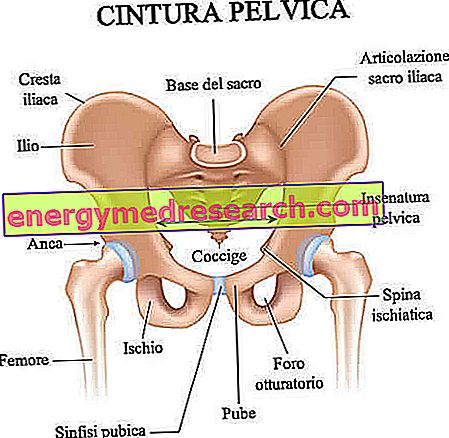Generality
The pubic symphysis is the cartilaginous type joint that connects the body of the right pubis with the body of the left pubis. The pubis, also known as pubic bone, is the lower and anterior region of the iliac bone.
The pubic symphysis resides in front and slightly above the urinary bladder and presents two very different cartilaginous components: on the two so-called articular surfaces, there is a coating of hyaline cartilage; between one articular surface and another, there is a fibrocartilage disk.
The pubic symphysis also includes a series of ligaments that give it stability.
The function of the pubic symphysis is to help the other sections of the hip bone and the sacrum to support the weight of the upper part of the human body.
Among the pathologies of the pubic symphysis, the most important is probably the diastasis of the pubic symphysis.

A brief review of what a symphysis is
A symphysis is a particular type of cartilaginous articulation .
The distinctive features of a symphysis consist in the presence, on the articular surfaces of the bones forming the joint, of a layer of hyaline cartilage and in the presence, between the aforementioned articular surfaces, of a fibrocartilaginous disc which serves to connect the two layers of cartilage aforementioned hyaline.
Types of articulation of the human skeleton
The joints of the human body can be divided into three main major categories:
- Fibrous joints;
- Cartilaginous joints;
- Synovial joints.
What is the symphysis pubis?
The pubic symphysis is the cartilaginous joint, which joins the right pubis to the left pubis.
The pubis is, together with ilio and ischio, one of the three bony components of the iliac bone, which is an equal anatomical element and is part of the so-called pelvic bones .
The precise position of the pubis is in front of the ischium and under the ilium.
BRIEF ANATOMICAL PUBLIC RECALL
The pubis, also known as pubic bone, is the component of the low and anterior iliac bone; the ischium develops behind the pubis, while the ilium takes place at the top.
The pubis has three anatomically relevant sections: the body of the pubis, the superior branch of the pubis and the inferior branch of the pubis .
The body is important, because a portion of it constitutes, with the same portion of the body of the contralateral pubis, the symphysis pubis; furthermore it has a bony prominence called pubic tubercle.
The upper branch is important, because it is the section that connects the pubis to the ile.
Finally, the lower branch is important, because it is the section that connects the pubis to the ischium and from which the so-called ischio-pubic branch originates; the ischio-pubic branch is a sort of bony arch that delimits a hole called the obturator hole .
Anatomy
The pubic symphysis resides in front of and slightly above the urinary bladder .
As anticipated, it is the pubic section known as the body that constitutes the pubic symphysis; to be precise, the part of the body that forms the pubic symphysis and represents its articular surface is the medial border, ie the edge closest to the sagittal plane . The medial border is covered by a layer of hyaline cartilage ; this is not surprising, since it is the articular surface of the pubic symphysis.
The fibrocartilage disk (the second of the two characteristic elements of a symphysis) is placed on the hyaline cartilage of each articular surface of the pubic body. The fibrocartilage disc is connected to a series of ligaments ; these ligaments have such an intimate relationship with the fibrocartilage disc, that some of their fibers "mix" with the fibers that make up the disc.
The pubic symphysis lacks blood vessels, so it is avascularized.
MOST IMPORTANT LINKS
Among the ligaments of the pubic symphysis, the so-called superior pubic ligament and the so-called inferior pubic ligament deserve a particular mention, due to their importance.
- Upper pubic ligament: with an extension ranging from the right pubic tubercle to the left pubic tubercle, this ligament connects the two pubic bones at the top. In addition to having a certain thickness, the upper pubic ligament is particularly strong and resistant; part of its robustness derives from its connection with the tendons of the rectus abdominal muscles, the external abdominal oblique, the gracilis and the hip muscles.
- Lower pubic ligament: also known as an arcuate pubic ligament or sub-pubic ligament, this ligament connects the two pubic bones at the bottom and represents the lower limit of the so-called pubic arch (or sub-pubic arch).
The other ligaments of the pubic symphysis are: the anterior pubic ligament and the posterior pubic ligament .
FIBROCARTILAGE DISC
The fibrocartilage disc is composed mainly of type I collagen fibers and chondrocytes (NB: the chondrocytes are the cells of the cartilaginous tissues). Type I collagen fibers are arranged in an orderly manner, parallel to each other.
Among the less important components of the fibrocartilage disc, glycosaminoglycans, which are long unbranched polysaccharides, deserve a particular mention.
The fibrocartilage disc lacks a perichondrium and has a fairly good self-repair capacity.
IALINE CARTILAGE
Like the other examples of hyaline cartilage present in the human body, also the hyaline cartilage of the pubic symphysis is bluish-white in color and has a low self-repairing capacity.
The low self-healing capacity of hyaline cartilage is due to the absence of blood vessels.
Some information on hyaline cartilage
Hyaline cartilage is the most common type of cartilage in the human skeleton. In addition to coating the articular surfaces, it also forms the costal cartilages, the nasal cartilages, the tracheal cartilages, the bronchial cartilages and the laryngeal cartilages.
PARTICULARITY OF THE PUBLIC SYMPTISM OF MAN AND WOMAN
The human pubic symphysis is anatomically different from the woman's pubic symphysis. These are few differences, but they deserve an emphasis.
In male subjects, the pubic symphysis hosts one of the two ends of the so-called penile suspensory ligament, which is absent in women.
In female individuals, on the other hand, the pubic symphysis is particularly close to the clitoris and presents, compared to men, a thicker fibrocartilage disc and a larger pubic arch.

Furthermore, in pregnant women, the ligaments of the pubic symphysis become more flexible; this change occurs in anticipation of the birth: the more flexible ligaments, in fact, increase the elasticity of the pubic symphysis, thus making the passage of the fetus easier, at the moment of birth.
Note : in women, a thicker fibrocartilage disc and a wider pubic arch than men provide more space for the fetus during a possible pregnancy.
Development
At birth, the width of the pubic symphysis measures approximately 9-10 millimeters. With advancing age, this measure is progressively reduced: already during adolescence, the symphysis of the pubis reaches the dimensions of adulthood (about 6 millimeters) and, around the age of about 50, it reaches almost 3 millimeters.
Aging, therefore, is a cause of degeneration of the pubic symphysis.
Function
The pubic symphysis helps the other sections of the iliac bone and the sacrum to support the weight of the upper part of the human body. Thus, the function of the pubic symphysis is to help the pelvic bones in their trunk support action.
MOVEMENT CAPACITY
Like all cartilaginous joints, the pubic symphysis is a joint element with very little mobility : in fact, it can move 2 millimeters, not more, and rotate by one degree.
This mobility varies in women, exclusively during pregnancy; the reasons for this have already been widely described.
Associated pathologies
Among the pathologies that can affect the pubic symphysis, the diastasis of the pubic symphysis, the dysfunction of the pubic symphysis and the disorders deriving from the presence of some specific metabolic or inflammatory diseases certainly deserve a mention.
DIASTASIS OF THE PUBLIC SYMPHISIS
The diastasis of the pubic symphysis is the separation of the pubic symphysis, without fractures. It is due to a dislocation of the right and / or left pubis.
The possible causes of this dislocation include: pregnancy, the act of birth, trauma to the pelvis, bladder exstrophy, imperfect osteogenesis, cleidocranial dysostosis, hypothyroidism and prune abdomen syndrome .
DYSFUNCTION OF THE PUBLIC SYMPTISM
The so-called dysphysis of the pubic symphysis is a painful condition, which arises as a result of excessive relaxation of the ligaments of the pubic symphysis. In fact, this excessive relaxation of the ligaments of the pubic symphysis causes a misalignment of the two pubic bones, a misalignment that is the real cause of the painful sensation.
Pubic symphysis dysfunction is a typical problem of pregnant women.
DISORDERS DERIVING FROM METABOLIC OR INFLAMMATORY DISEASES
Metabolic diseases such as renal osteodystrophy and ochronosis cause a widening of the pubic symphysis and the formation of calcific deposits on the pubic symphysis, respectively.
Inflammatory diseases such as ankylosing spondylitis and pubic osteitis (or pubic osteitis) cause fusion of the pubic symphysis bones and an intense pain sensation in the pubic region, respectively.



